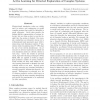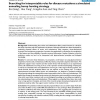247 search results - page 36 / 50 » Predicting Success in Machine Translation |
EMNLP
2008
13 years 9 months ago
2008
While phrase-based statistical machine translation systems currently deliver state-of-theart performance, they remain weak on word order changes. Current phrase reordering models ...
COLING
1996
13 years 8 months ago
1996
The development of natural language proccssing (NLP) systems that perform machine translation (MT) and information retrieval (IR) has highlighted the need for the automatic recogn...
ICML
2009
IEEE
14 years 2 months ago
2009
IEEE
Physics-based simulation codes are widely used in science and engineering to model complex systems that would be infeasible to study otherwise. Such codes provide the highest-fid...
COLT
2008
Springer
13 years 9 months ago
2008
Springer
Boosting algorithms build highly accurate prediction mechanisms from a collection of lowaccuracy predictors. To do so, they employ the notion of weak-learnability. The starting po...
BMCBI
2006
2006
Searching for interpretable rules for disease mutations: a simulated annealing bump hunting strategy
13 years 7 months ago
Background: Understanding how amino acid substitutions affect protein functions is critical for the study of proteins and their implications in diseases. Although methods have bee...


